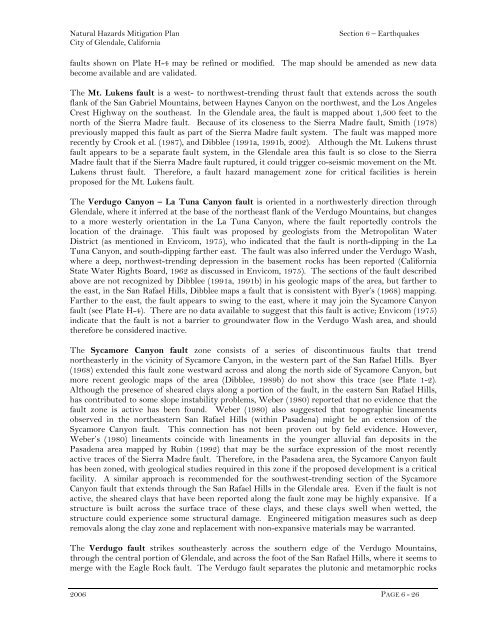Glendale (PDF) - Hazard Mitigation Web Portal - State of California
Glendale (PDF) - Hazard Mitigation Web Portal - State of California
Glendale (PDF) - Hazard Mitigation Web Portal - State of California
- No tags were found...
You also want an ePaper? Increase the reach of your titles
YUMPU automatically turns print PDFs into web optimized ePapers that Google loves.
Natural <strong>Hazard</strong>s <strong>Mitigation</strong> PlanCity <strong>of</strong> <strong>Glendale</strong>, <strong>California</strong>Section 6 – Earthquakesfaults shown on Plate H-4 may be refined or modified. The map should be amended as new databecome available and are validated.The Mt. Lukens fault is a west- to northwest-trending thrust fault that extends across the southflank <strong>of</strong> the San Gabriel Mountains, between Haynes Canyon on the northwest, and the Los AngelesCrest Highway on the southeast. In the <strong>Glendale</strong> area, the fault is mapped about 1,500 feet to thenorth <strong>of</strong> the Sierra Madre fault. Because <strong>of</strong> its closeness to the Sierra Madre fault, Smith (1978)previously mapped this fault as part <strong>of</strong> the Sierra Madre fault system. The fault was mapped morerecently by Crook et al. (1987), and Dibblee (1991a, 1991b, 2002). Although the Mt. Lukens thrustfault appears to be a separate fault system, in the <strong>Glendale</strong> area this fault is so close to the SierraMadre fault that if the Sierra Madre fault ruptured, it could trigger co-seismic movement on the Mt.Lukens thrust fault. Therefore, a fault hazard management zone for critical facilities is hereinproposed for the Mt. Lukens fault.The Verdugo Canyon – La Tuna Canyon fault is oriented in a northwesterly direction through<strong>Glendale</strong>, where it inferred at the base <strong>of</strong> the northeast flank <strong>of</strong> the Verdugo Mountains, but changesto a more westerly orientation in the La Tuna Canyon, where the fault reportedly controls thelocation <strong>of</strong> the drainage. This fault was proposed by geologists from the Metropolitan WaterDistrict (as mentioned in Envicom, 1975), who indicated that the fault is north-dipping in the LaTuna Canyon, and south-dipping farther east. The fault was also inferred under the Verdugo Wash,where a deep, northwest-trending depression in the basement rocks has been reported (<strong>California</strong><strong>State</strong> Water Rights Board, 1962 as discussed in Envicom, 1975). The sections <strong>of</strong> the fault describedabove are not recognized by Dibblee (1991a, 1991b) in his geologic maps <strong>of</strong> the area, but farther tothe east, in the San Rafael Hills, Dibblee maps a fault that is consistent with Byer’s (1968) mapping.Farther to the east, the fault appears to swing to the east, where it may join the Sycamore Canyonfault (see Plate H-4). There are no data available to suggest that this fault is active; Envicom (1975)indicate that the fault is not a barrier to groundwater flow in the Verdugo Wash area, and shouldtherefore be considered inactive.The Sycamore Canyon fault zone consists <strong>of</strong> a series <strong>of</strong> discontinuous faults that trendnortheasterly in the vicinity <strong>of</strong> Sycamore Canyon, in the western part <strong>of</strong> the San Rafael Hills. Byer(1968) extended this fault zone westward across and along the north side <strong>of</strong> Sycamore Canyon, butmore recent geologic maps <strong>of</strong> the area (Dibblee, 1989b) do not show this trace (see Plate 1-2).Although the presence <strong>of</strong> sheared clays along a portion <strong>of</strong> the fault, in the eastern San Rafael Hills,has contributed to some slope instability problems, <strong>Web</strong>er (1980) reported that no evidence that thefault zone is active has been found. <strong>Web</strong>er (1980) also suggested that topographic lineamentsobserved in the northeastern San Rafael Hills (within Pasadena) might be an extension <strong>of</strong> theSycamore Canyon fault. This connection has not been proven out by field evidence. However,<strong>Web</strong>er’s (1980) lineaments coincide with lineaments in the younger alluvial fan deposits in thePasadena area mapped by Rubin (1992) that may be the surface expression <strong>of</strong> the most recentlyactive traces <strong>of</strong> the Sierra Madre fault. Therefore, in the Pasadena area, the Sycamore Canyon faulthas been zoned, with geological studies required in this zone if the proposed development is a criticalfacility. A similar approach is recommended for the southwest-trending section <strong>of</strong> the SycamoreCanyon fault that extends through the San Rafael Hills in the <strong>Glendale</strong> area. Even if the fault is notactive, the sheared clays that have been reported along the fault zone may be highly expansive. If astructure is built across the surface trace <strong>of</strong> these clays, and these clays swell when wetted, thestructure could experience some structural damage. Engineered mitigation measures such as deepremovals along the clay zone and replacement with non-expansive materials may be warranted.The Verdugo fault strikes southeasterly across the southern edge <strong>of</strong> the Verdugo Mountains,through the central portion <strong>of</strong> <strong>Glendale</strong>, and across the foot <strong>of</strong> the San Rafael Hills, where it seems tomerge with the Eagle Rock fault. The Verdugo fault separates the plutonic and metamorphic rocks2006 PAGE 6 - 26
















